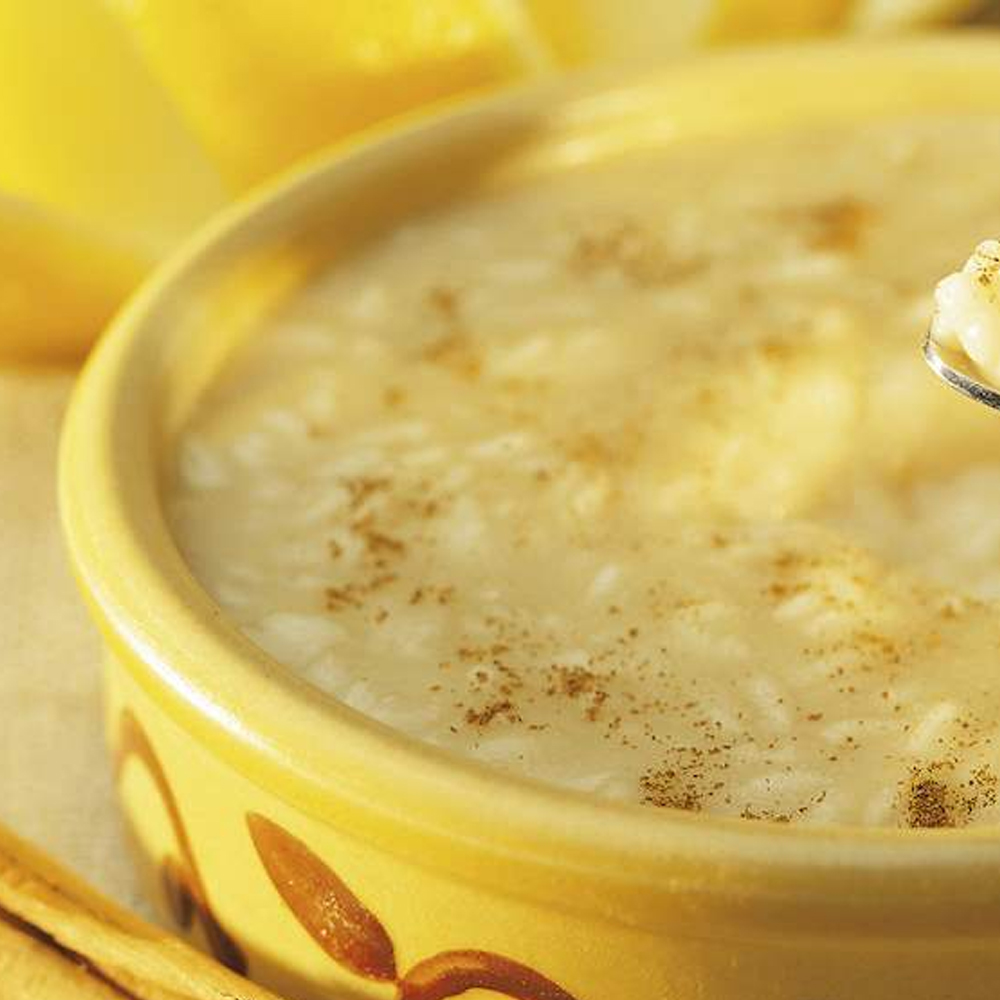Qurabiya
The decorative qurabiyas are Iranian shortbread cookies made with ground blanched almonds, egg whites, sugar, and a small amount of flour. The batter is piped into circular shapes, and the cookies are then baked until crispy. Before they are put in the oven, qurabiyas are usually decorated with chopped pistachios, which provide a nice decorative contrast to the pale dough.
It is believed that they have originated in the Iranian city of Tabriz, located in the eastern part of the country, where they can be found in almost every traditional bakery. Most commonly, tourists buy them as convenient Tabriz souvenirs. These soft and chewy sweet biscuits have an immensely important place in the Iranian culture, especially during wedding ceremonies.
Since ancient times, platters with freshly baked qurabiya cookies have been given as a gift to the bride by the groom’s family. They are also a common dessert staple during Iranian celebrations, especially Nowruz, the Persian New Year festivity.
Tradition suggests that this sweet decorative dessert should be enjoyed alongside freshly brewed chai.
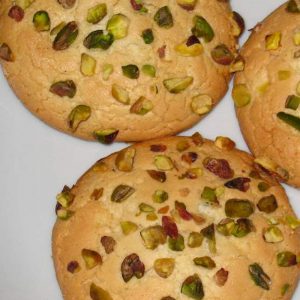
Tar halva
This halva variety is one of the most traditional versions in Iran. Although regional varieties may slightly differ in some ingredients and consistency, tar halva usually consists of toasted rice flour that is combined with butter, cardamom, and a saffron-flavored syrup scented with rose water.
This simple dessert is usually decorated and garnished with rose petals or pistachios. Tar is translated as moist, referring to the soft, paste-like texture of halva.

Halva ye havij
This vibrant halva variety is prepared with a base of shredded carrots, rice flour, butter, sugar, and various flavorings and spices such as saffron, rose water, cinnamon, or cardamom. Carrot halva can be served on a large plate and shared as a communal meal, but since the base is incredibly pliable, it can be molded and shaped into various other forms and served as a single portion.
It can be enjoyed well-chilled or lukewarm, and it is usually garnished with pistachios, walnuts, or ground cinnamon.
Havij bastani
Havij bastani is a delicious and unusual Iranian take on an ice cream float. This refreshing dessert combines fresh carrot juice and a scoop of ice cream, preferably vanilla-flavored or more traditional saffron-infused version. Often considered as both a beverage and a dessert, havij bastani can be sipped or eaten with a spoon.
It is always served in a glass, and it is usually topped with crushed pistachios, as well as cardamom or cinnamon.
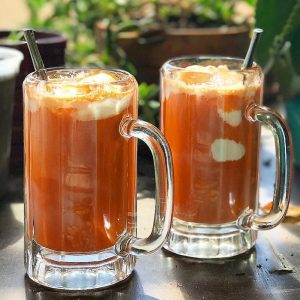
Sohan asali
Sohan asali is a traditional Iranian brittle prepared with a base of sugar, honey, saffron, rose water, oil or butter, and slivered almonds. They are usually round, and before they set, the top is decorated with ground pistachios. This sweet, crispy candy is a staple on Persian New Year, and it is often altered with the addition of various flavorings, other nuts, or flavored honey.
It is believed that sohan asali has its origins in Isfahan, a region known for its honey production.
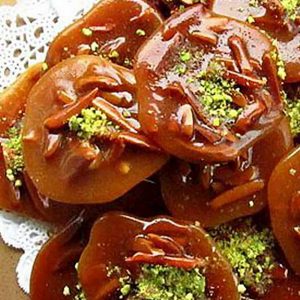
Koloocheh
Koloocheh are traditional Iranian cookies which are usually round-shaped and consist of a crunchy shell and a sweet, soft interior. The shell is typically prepared with the plain butter and flour dough, but it is also intricately decorated with a traditional stamp pattern.
The most common filling is a delectable mixture of ground walnuts and sugar, but dates and grated coconut are also often used in some parts of Iran. The cookie is usually spiced with saffron, rose water, cardamom, cinnamon, or citrus zest, providing the unmistakable oriental flavors and enticing aromas.
Koloocheh are an important part of every celebration in Iran, and they are the staple dessert served during Nowruz, the Iranian New Year festivity. Although they are traditionally baked at home, with each family having their unique traditional recipe, they can also be found already prepared in numerous bakeries and grocery stores.
Although koloocheh is an ideal dessert for entertaining, served alongside tea or coffee, it is also often used as a delicious Iranian souvenir.
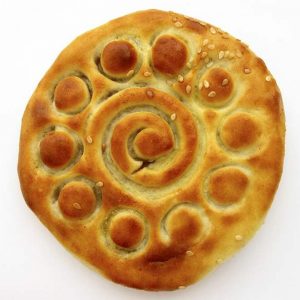
Cake Yazdi
Yazdi cakes are small and fragrant cakes that hail from central Iran. They are made with a simple mixture that usually incorporates eggs, sugar, flour, oil, and milk or yogurt, while their typical flavor comes from the addition of rosewater and cardamom.
Saffron is also occasionally added. The cakes are traditionally prepared in small metal tins, while homemade versions can be made in paper cups or muffin tins. Each cake is typically topped with slivered almonds, pistachios, or sesame seeds. As the name suggests, these soft and fragrant cakes originate from the city of Yazd, and they are often made for religious ceremonies and various special occasions.
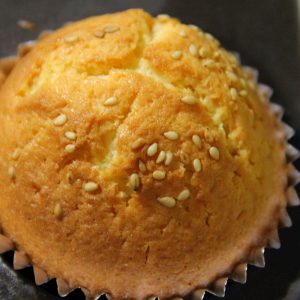
Qottab
Deep-fried qottab pastries are traditional Iranian sweets consisting of soft wheat dough wrapped around almond or walnut fillings. They are usually generously spiced with cinnamon, rose water, cardamom, and orange blossom, then shaped into round or crescent forms.
Small in size and dusted with powdered sugar, they are a staple dessert served at numerous Iranian festivities and celebrations. Even though they originated in Yazd, nowadays these delectable sweets are prepared and enjoyed throughout the country.
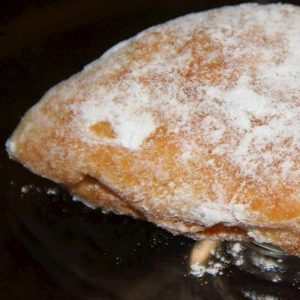
Khoresht mast
Khoresht mast is a traditional Iranian dish hailing from Isfahan. Although it’s often dubbed yogurt stew, khoresht mast is actually an unusual dessert that’s often served as a side dish or an appetizer, made with a combination of sugar, rose water, yogurt, saffron, onions, egg yolks, turmeric, and crushed lamb neck meat.
The combination is boiled and mixed thoroughly before the addition of walnuts, pistachios, or almonds. Once prepared, khoresht mast is cooled and topped with barberries before serving. In the past, it was served as a main dish in massive feasts that were held by kings.

Naan berenji
Naan berenji are light and crunchy Iranian cookies made with rice flour. They are usually flavored with rose water or cardamom, formed into flat, round shapes, then decorated with poppy seeds, pistachios, or barberries. These traditional cookies are typically prepared and enjoyed on Iranian New Year as a light afternoon dessert accompanied by a warm cup of coffee or tea.
Even though they are eaten throughout the country, naan berenji cookies from the Kermanshah region are believed to be the most authentic variety.
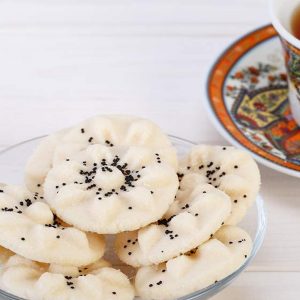
Zulbia
Although it is believed to have its origins in Persia, zulbia or jalebi is an international dessert with variations that spread throughout the Middle East, India, and Asia. In its basic form, this sweet dessert is created by combining flour with yogurt or ghee, as well as baking soda or yeast to create a batter which is then poured in circular patterns directly into the sizzling oil.
The final result is a crispy treat that is then doused in a thick syrup, which can be flavored with rosewater, saffron, honey, orange blossom water, or cardamom. In both Iran and India, zulbia is served on special occasions, and it is usually sprinkled with chopped pistachios or saffron threads.
In India, it is occasionally paired with a dense, milk-based rabri.
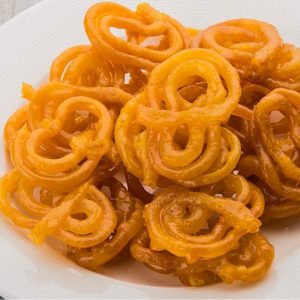
Gaz
Gaz is the Iranian variety of nougat. Nowadays it is mostly prepared with a blend of egg whites, sugar, and nuts, but the original gaz consists of slightly different ingredients. The raw gaz is an exudate of an insect, which is found and collected from wild tamarisk trees.
After it has been collected, it is melted, sieved, mixed with nuts, then flavored with typical aromas such as rose water and saffron. Finally, gaz is shaped into logs or rectangles and cut into smaller pieces. Traditionally produced gaz is a seasonal ingredient, native to the city of Isfahan, which is abundant with tamarisk trees.
Since it is a rare ingredient, raw gaz is often mixed with egg whites or entirely substituted with a blend of egg whites and sugar syrup. Gaz is a popular sweet treat across Iran and is traditionally associated with special and festive occasions. Since it transports easily, it is one of the favorite Iranian souvenirs.
Iranians prefer to eat it as a snack alongside warm tea or sherbet.
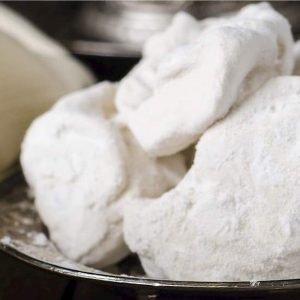
Pashmak
Pashmak is a traditional Iranian sweet, similar to cotton candy. It is made with flavored sugar syrup that is gently pulled until multiple thin and fragile threads are created. The final product resembles hair or wool, which is soft, yet dense and heavy, and is often referred to as angel’s hair.
This traditional confectionery is believed to have originated in the Iranian city of Yazd, and today it is usually factory-produced. It is typically flavored with sesame, rose water, cardamom, orange blossom, saffron, vanilla, or pistachio. In Iran, it is not common to eat it on its own, and it is usually incorporated into other desserts.
Because of its unusual and decorative appearance, pashmak is often served on top of cakes, ice creams, puddings, and drinks. Although this sweet treat is mainly produced in Iran, it can occasionally be found in international supermarkets around the world, packed in firmly secured bags.

Bastani sonnati
Bastani sonnati is a unique saffron-infused Iranian ice cream that was invented at the beginning of the 20th century by Akbar Mashti, the first ice cream vendor in Tehran. This frozen treat is made with a creamy mixture of milk or cream, frozen custard, and sliced pistachios.
It is flavored with rose water and saffron and traditionally incorporates salep, an ingredient extracted from wild orchids. The vibrant yellow color and exotic flavors make bastani one of the favorite Iranian sweets. Iranians prefer to enjoy it in individual bowls, sprinkled with shredded pistachio, or served within two plain wafers, when it’s known as bastani nooni ice cream sandwich.

Sholeh zard
Saffron rice pudding known as sholeh zard is an ancient Iranian dessert that was once served only on special occasions. The rice is cooked in water and then enriched with saffron and sugar, while common additions include slivered nuts and spices such as cardamom and cinnamon.
Sholeh zard is typically served in individual-sized portions and comes garnished with ground cinnamon, slivered almonds, or pistachios.
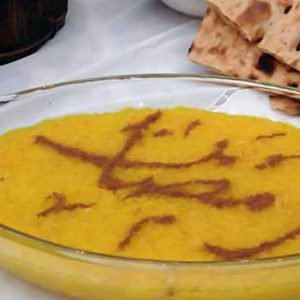
Faloodeh
Iranian faloodeh is a traditional sorbet which consists of frozen sugar syrup infused with rose water and mixed with thin vermicelli noodles. According to popular belief, faloodeh originated in Shiraz and is one of the first sorbet varieties in the world, dating back to 400 BC.
In Iran, it is usually served drizzled with fresh lime juice, chopped pistachios, or sweet cherry syrup, and enjoyed as a refreshing summer dessert.
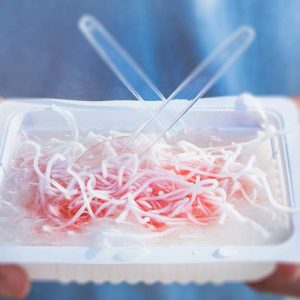
Mast o khiar
Mast o khiar is a simple and refreshing Iranian dip made with yogurt and diced cucumbers. In its original form, it is generously seasoned with mint, but it can be easily adapted with other ingredients such as garlic, walnuts, raisins, and various herbs and spices.
Served chilled, mast o khiar is a staple side dish of every Iranian meal but also a quick and nutritious snack when accompanied by crispy flatbreads.
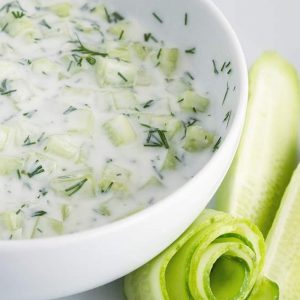
Ranginak
Hailing from Shiraz, this traditional Iranian dessert is prepared with toasted wheat flour and walnut-stuffed dates. Toasted flour, which is usually enriched with cinnamon, sugar, and cardamom, makes the bottom and the top layer of the dessert, while the center is filled with stuffed dates.
Ranginak is prepared in round cake pans and usually comes topped with ground pistachios. The cake is traditionally served chilled, usually accompanied by freshly brewed tea.
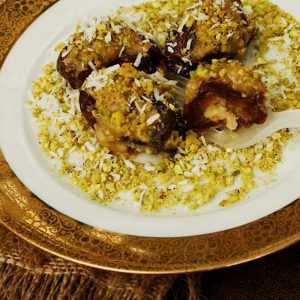
Masghati
One of the most famous Iranian desserts is the soft and colorful masghati. The base of this traditional confectionery is a mixture of liquids such as water or milk, combined with starch and sugar. When cooled, the starch solidifies the liquid and creates a delicate, firm, and almost jelly-like sweet treat.
The base is highly versatile and is usually incorporated with traditional Iranian spices and ingredients to provide different flavor combinations. Typical additions include rose water, cardamom, saffron, pomegranate juice, pomegranate seeds, and crushed or chopped nuts.
When cooled, they can be cut into different shapes such as diamonds or rectangles, and can even come served in individual bowls or molds. Iranians prefer to enjoy them during ceremonies and festivities when they are lavishly and intricately decorated.
Since masghati treats are easy to make, they are also regarded as a simple everyday dessert, best served alongside a cup of tea. Masghati is a signature confectionery of the Fars province, and one of the authentic souvenirs of the area.
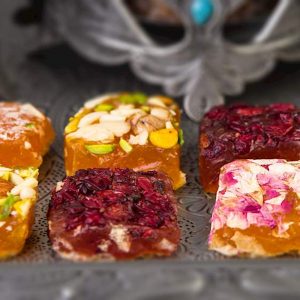
Nogha
Nogha is a variety of the widely popular Iranian nougat called gaz. Originally, Iranian nougat was made with an unusual exudate of an insect inhabiting wild tamarisk trees. The solid exudate was melted and sieved to create the rich and sweet base of the nougat.
Today, the original method is usually replaced with a more available mixture of sugar and beaten egg whites, which produces a product similar in texture and flavor to the original gaz. Nogha is one of the numerous varieties found in the country, typically eaten in the Azerbaijan-Iran region.
It is typically made with chopped walnuts, unlike other types which mainly use pistachios and almonds. Nogha gaz is usually spread between two thin wafers and is often cut into larger rectangular shapes. The sweet taste, sticky texture, and crunchy walnuts make nogha an immensely popular confectionery, eaten as a dessert or a sweet snack.
Because of its beautiful visual appearance, it is often given as a gift or a traditional and authentic Iranian souvenir.
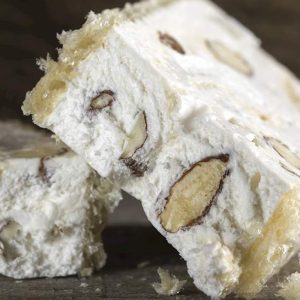
Halva ardeh
Halva ardeh is a sweet, dense Iranian paste that is usually prepared with a base of sugar and ground sesame or tahini. The mixture is occasionally studded with pistachios, but it is traditionally merely topped with pistachio slivers. Though it can be enjoyed as a sweet snack, halva ardeh is a common breakfast staple and is occasionally served with bread on the side.
This classic confectionery item should not be mistaken with other halva varieties that can be prepared with different combinations of flour, lentils, butter, nuts, rose water, and saffron.
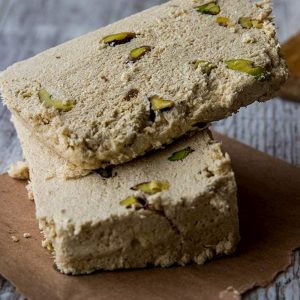
Noghl
Noghl are popular Iranian sugar-coated almonds. Sugar, water, and rosewater are boiled to create a homogenous liquid in which the roasted almonds are quickly submerged. When cooled, the coating solidifies, creating a sweet and crunchy white layer around the almonds.
Since they symbolize happiness and good luck, these bright white treats are an important part of Iranian wedding traditions. They are served at the end of every Iranian wedding, usually accompanied by tea. Besides weddings, noghl can also be consumed as an everyday treat, alongside a hot cup of coffee or tea.
They are also popular at Afghan weddings, where they are thrown at newlywed couples instead of confetti. Sugary noghl is usually factory-produced and sold in bags or plastic containers
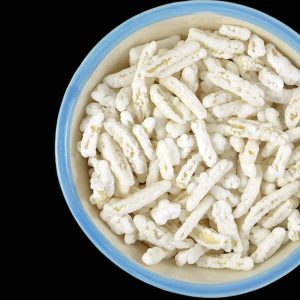
https://www.tasteatlas.com/

